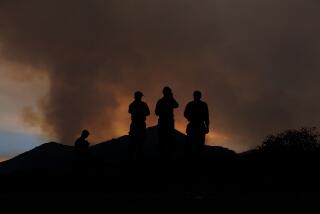Exhausted crews find respite at command post
- Share via
After more than two days of combating flames and hacking away at brush with axes and chain saws, hundreds of exhausted firefighters tried to steal a few minutes’ sleep on Saturday morning in a makeshift city that sprouted almost overnight along a rural road in Camarillo.
Then, with flames hopscotching along nearby ridgelines, the firefighters from as far away as Oregon, Idaho and Arizona geared up once again to protect lives and property from the devastating wildfire.
The mini-city known as the Springs Fire Incident Command Post is equipped to serve three meals a day — along with providing medical supplies, shower and laundry facilities and tents to catnap in — to the 1,865 firefighters deployed to Ventura County over the last three days.
Many of them drove here in family vehicles or were driven in government buses and trucks. Others caravanned in fire engines to work fire lines on 24-hour shifts.
Despite slackening winds, cooler temperatures and forecasts of possible rain for Sunday, the battle against the first major fire of the year was far from over for these firefighters and only the beginning of what could be one of the worst fire seasons in decades statewide. By late Saturday, the fire had burned 28,000 acres and was 56% contained.
A lack of winter and spring rains has resulted in dry conditions across the state, leading to a number of unseasonably large wildfires, officials with the California Department of Forestry and Fire Protection said. Since Jan. 1, Cal Fire has responded to more than 600 wildfires — more than 200 over the average for this time of year.
Even before this week’s fires began, fire authorities had begun deploying engines, hand crews and equipment from several western states to potential hot spots.
Almost immediately, the Panther fire charred about 6,700 acres in the Northern California community of Butte Meadows and continues to burn.
Cal Fire authorities were concerned that the Springs fire, which erupted Thursday, would rage out of control because of developing weather conditions, and they feared significant property losses.
They decided to dispatch hundreds of firefighters to Ventura County and house them in the incident command center that unfolded in a park sandwiched between agricultural fields and Camarillo Airport.
Arnold Lopez, 26, said he was among 18 “hot shots” from Silver City, N.M., originally deployed Wednesday to a staging area in Hemet “to wait for a fire.”
The next morning, his crew was reassigned to Camarillo, where they worked 30 hours clearing brush, conducting back burns and digging firebreaks with hand tools and chain saws.
Lopez was bedraggled, hungry and desperate for sleep when he marched into the incident post Saturday morning.
“To be in SoCal this early in the year for this big of a fire could set up a concerning trend,” said Lopez. “I’m pretty sure I’ll be back again.”
Fresno Fire Department Battalion Chief Charles Tobias and his family knew what to expect when they were awakened by a telephone call at 1 a.m. Friday.
“My wife asked, ‘You going to the big fire in Southern California?’” Tobias recalled as he and dozens of colleagues grabbed a light breakfast at sunrise. “I said yes. She said, ‘When are you coming home?’
“I told her I had no idea — and I still don’t,” he said. “That’s the kind of work I do. And this year, it looks like we’ll be deployed from one big fire to another through November.”
By Saturday afternoon, the park was base camp for 247 fire engines and nearly 2,000 men and women whose mission had abruptly shifted from aggressive firefighting to mop-up operations and helping residents safely return to their homes in areas that had been evacuated.
The total cost of the Springs fire operation was $4.5 million and rising, according to Capt. Michael Lindbery of the Ventura Fire Department.
“If everything goes well today, and the weather behaves tomorrow, we’ll be rapidly shrinking this base camp,” Lindbery said, as fire engines rumbled past, helicopters roared overhead and beleaguered firefighters sprawled on the grass. “By next week it will be nearly gone.”
More to Read
Sign up for Essential California
The most important California stories and recommendations in your inbox every morning.
You may occasionally receive promotional content from the Los Angeles Times.











